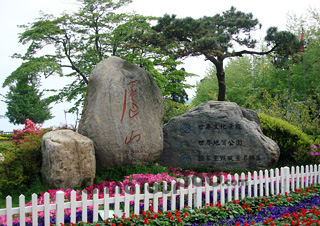 Lushan Mountain
Lushan Mountain A Statue in Lushan Mountain
A Statue in Lushan Mountain Flower Path in Lushan
Flower Path in Lushan A Temple on Lushan Mountain
A Temple on Lushan Mountain
Lushan National Park in the Jiangxi Province has been listed as a World Heritage by UNESCO as of 1996. The exceptional landscapes found here, combined with its great contribution to the development of Chinese civilization, have convinced the whole world of the importance of Lushan National Park.
Lushan Mountain lies to the south of Jiujiang City of Jiangxi Province, facing the Yangtze River in the North and connecting the Poyang Lake in the East. Covering an area of over 300 square kilometers (74,132 acres), the mountain embraces more than 90 peaks. And the highest peak, Hanyang Peak, measures 1,474 meters. Gullies, springs, waterfalls and caves as well as a great many cultural relics can be found inside.
To better understand this renowned mountain, the following points are made in terms of geological features, spiritual landmarks, and natural scenic spots.
![]() Geological Features
Geological Features
Lushan Moutain lies in the region where a full range of stratums (except that of the Trias) are in evidence, presenting the process of crustal evolvement. It is a fault-block mountain created in the Fourth Epoch. The fourth glacial epoch found in this area provided valuable material for research about the ancient glaciers in China. At the foot of the mountain you can find the unique sand dunes created by the monsoons at the end of the Ice Age. Blessed with such varied geological structures, the mountain had been adored by geologists in China and from abroad.
![]() Spiritual Landmarks
Spiritual Landmarks
The World Heritage Committee value the Lushan National Park mostly on the culture criteria. The park has recorded the travel of countless celebrities in all ages past. Thus more than 4,000 poems and literary works have been left in the mountains. The renowned Bailudong Academy (White Deer Hole Academy) founded on the mountain in the year 940 DC leads the four most renowned ancient institutes in China. Zhu Xi, a profound ideologist and educationist in the Song Dynasty (960 - 1279), made the 'Announce in the White Deer Hole Academy' criterion of academies and institutes. His theory not only influenced China but also East Asia.
Five religions' believe they have found their Pure Land in Mount Lushan, which is a rare thing for any place. As early as 391 DC, a Buddhist named Hui Yuan established Donglin Temple and there did missionary work for more than 36 years, which enabled the mountain became the center of Buddism in Southern China. In the 5th century, Taoism began to make a significant impact. During the Ming (1368 - 1644) and Qing Dynasties (1644 - 1911), Churches of Christianity and Catholicism as well as Islamism had been built among the mountain.
Hundreds of villas bearing distinct architectural styles of foreign countries are well preserved among the mountain. This spectacle can only be appreciated in the Lushan Mountains, and is unique in all of China.
![]() Natural Scenic Spots
Natural Scenic Spots
Lushan National Park is blessed with various landscapes. Just as a famous poem describes, the grotesque mountain peaks show different perspectives at different view points. And they appear much more charming in the floating mist. Visitors find lakes and pavilions dotted among the green covered mountains. With forest coverage being 70%, the park is rich in wildlife. There are up to 3,000 plant varieties and 171 bird species as well as 33 animal species. White cranes found in the areas of Lushan Mountain and the Poyang Lake are the biggest white crane flock in the world with a total number of over 4,000.
All in all, blessed with mild climate and burden-releasing scenery, Lushan National Park is waiting for your presence. Do not miss it!
![]() Entrance Fee:
Entrance Fee:
CNY 180 (Apr. to Nov.); CNY 135 (Dec. to Mar.)
Free from Jan. 1 to Jan. 31, 2011
(Free for kids under 1.4 m and senior citizens over 70 years old)
![]() Transportation:
Transportation:
A. Take the buses or mini buses at Jiujiang Long-distance Bus Station and get off at Lushan;
B. From Jiujiang Railway Station: Take the Tourism Bus to Lushan Guling (50 minutes; CNY 15);
C. From Jiujiang Passenger Transport Wharf: Take the mini bus to Lushan.







